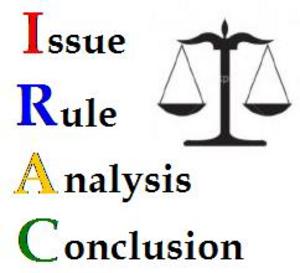While working in a law office as a paralegal or other research position, your supervising attorney will request that you make a written analysis of each case you research. He/She will more than likely expect that you know how to do this. The results of your legal analysis should be put into writing so that they can be used in the future in addition to the case at hand. The written analysis will likely mirror your thought process during your research. This written analysis of a case needs to be concise and to the point. All of the necessary facts must be present but an attorney or judge basically wants to know four things:
Issue-what your client’s problem is
Rule-what the rule is
Analysis-how that law will affect your client’s case
Conclusion-what you expect to be the likely result
One widely accepted method for conveying your thoughts in a logical order is known as IRAC. IRAC is an acronym for Issue, Rule, Analysis, and Conclusion. The IRAC approach is certainly not the only approach and nor is it always the best, but it is always a very good starting point. Here is the basic information to be contained in each of the IRAC elements:
Issue
Create a topic sentence that states the issue you will be discussing in the paragraph. Again, make this brief and concise. Only use one issue in this paragraph. If your case includes different issues, use the IRAC method for each issue.
Rule
In this section, you need to state the rule of law that you found to govern the particular issue at hand. Be sure to quote the exact statutory language. However, if the statute is long, quote only the relevant language. You should use ellipses to show any omissions but be sure that your omissions do not change the rule or statute’s meaning.
Analysis
Now you need to explain how the statute and policy of the statute will determine the outcome of your client’s case. Be sure to note the strengths as well as the weaknesses of your argument so that your attorney can be prepared. You will also be doing your client a great disservice by not pointing out the pros and cons of your application of the law to his or her case.
Conclusion
You must conclude the analysis. You cannot leave your reader to make their own conclusion because that is what you were asked to do. Tell your reader what the outcome of the case is likely to be in relation to the research.
As noted earlier, this IRAC method is to be used for each issue pertaining to the facts of your client’s case. Include a paragraph for each issue. Also include in your written analysis a “road map” paragraph that outlines the events that led to the case. Tell your reader what happened to get your client to this point. After using the IRAC method on all of your issues, include a concluding paragraph. This will include the incorporation of all of the elements and issues of the case and how the case is likely to turn out based on your legal analysis.
When working in a law office you must also first consult with your supervising attorney on what he or she prefers. Some attorneys would rather use a CRAC method that starts with a conclusion. Many attorneys still find this IRAC method to be very effective in conveying a legal analysis. Also be sure to use transitions to help your reader move from one thought to the next and to see the connections between them. Legal research is often regarded as the most important job a legal assistant has in a law office, however without an effective way of communicating that research to your attorney, it is just a thought.




